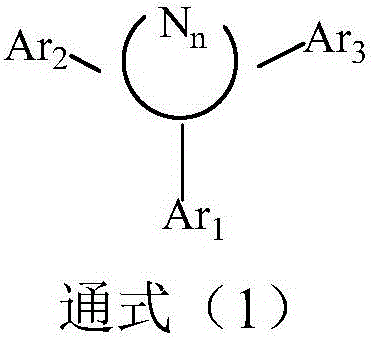Organic compound taking pyridine as core and application thereof to OLED
An organic compound, azabenzene technology, applied in the application field of organic electroluminescent devices, can solve the problems of low S1 state radiation transition rate, difficult exciton utilization rate, high fluorescence radiation efficiency, efficiency roll-off and the like
- Summary
- Abstract
- Description
- Claims
- Application Information
AI Technical Summary
Problems solved by technology
Method used
Image
Examples
Embodiment 1
[0071] Embodiment 1: the synthesis of compound 1:
[0072] synthetic route:
[0073]
[0074] In a 250ml four-neck flask, under nitrogen atmosphere, add 0.01mol 4-bromo-2,6-di(2-thienyl)pyridine, 0.015mol intermediate A1, 0.03mol sodium tert-butoxide, 1×10 -4 mol Pd 2 (dba) 3 , 1×10 -4 mol of tri-tert-butylphosphine, 150ml of toluene, heated to reflux for 24 hours, sampling plate, the reaction was complete; naturally cooled, filtered, the filtrate was rotary evaporated, and passed through a silica gel column to obtain the target product with a purity of 99.1% and a yield of 68.4%.
[0075] Elemental analysis structure (molecular formula C 41 h 25 N 3 OS 2 ): theoretical value C, 76.97; H, 3.94; N, 6.57; O, 2.50; S, 10.02; test value: C, 76.98;
[0076] HPLC-MS: The molecular weight of the material is 639.14, and the measured molecular weight is 639.37.
Embodiment 2
[0077] Embodiment 2: the synthesis of compound 4:
[0078] synthetic route:
[0079]
[0080] In a 250ml four-neck flask, under a nitrogen atmosphere, add 0.01mol 2,5-dibromopyrazine, 0.025mol intermediate B1, 0.04mol sodium tert-butoxide, 2×10 -4 mol Pd 2 (dba) 3 , 2×10 -4 mol of tri-tert-butylphosphine, 150ml of toluene, heated to reflux for 24 hours, sampling plate, the reaction was complete; naturally cooled, filtered, the filtrate was rotary evaporated, and passed through a silica gel column to obtain the target product with a purity of 99.2% and a yield of 63.7%.
[0081] Elemental analysis structure (molecular formula C 60 h 36 N 6 o 2 ): theoretical value C, 82.55; H, 4.16; N, 9.63; O, 3.67; test value: C, 82.53; H, 4.17; N, 9.64;
[0082] HPLC-MS: The molecular weight of the material is 872.29, and the measured molecular weight is 872.51.
Embodiment 3
[0083] Embodiment 3: the synthesis of compound 12:
[0084] synthetic route:
[0085]
[0086] In a 250ml four-necked flask, under nitrogen atmosphere, add 0.01mol 2-(4-bromophenyl)-5-phenylpyrazine, 0.015mol intermediate C1, 0.03mol sodium tert-butoxide, 1×10 -4 mol Pd 2 (dba) 3 , 1×10 -4 mol of tri-tert-butylphosphine, 150ml of toluene, heated to reflux for 24 hours, sampling point plate, the reaction was complete; natural cooling, filtration, filtrate rotary evaporation, silica gel column, the target product was obtained with a purity of 98.7% and a yield of 65.6%.
[0087] Elemental analysis structure (molecular formula C 49 h 34 N 4 O): Theoretical value C, 84.70; H, 4.93; N, 8.06; O, 2.30; Test value: C, 84.72; H, 4.92; N, 8.05;
[0088] HPLC-MS: The molecular weight of the material is 694.27, and the measured molecular weight is 694.49.
PUM
| Property | Measurement | Unit |
|---|---|---|
| Thickness | aaaaa | aaaaa |
| Thickness | aaaaa | aaaaa |
| Thickness | aaaaa | aaaaa |
Abstract
Description
Claims
Application Information
 Login to View More
Login to View More - R&D Engineer
- R&D Manager
- IP Professional
- Industry Leading Data Capabilities
- Powerful AI technology
- Patent DNA Extraction
Browse by: Latest US Patents, China's latest patents, Technical Efficacy Thesaurus, Application Domain, Technology Topic, Popular Technical Reports.
© 2024 PatSnap. All rights reserved.Legal|Privacy policy|Modern Slavery Act Transparency Statement|Sitemap|About US| Contact US: help@patsnap.com










